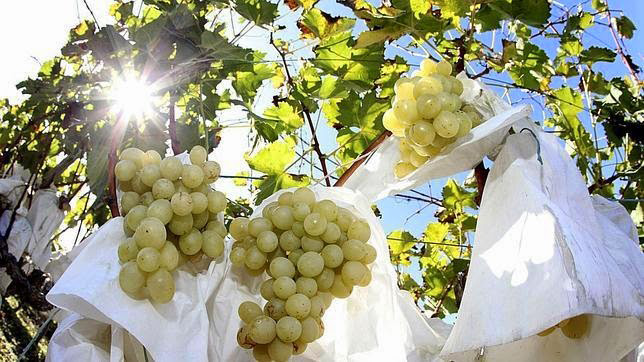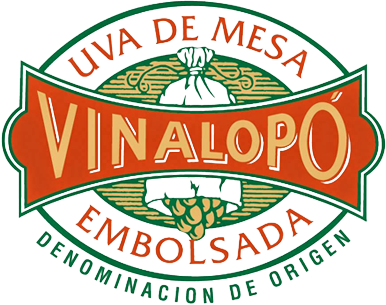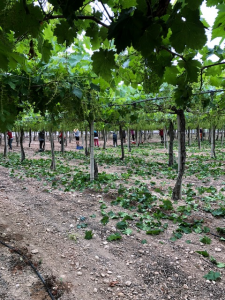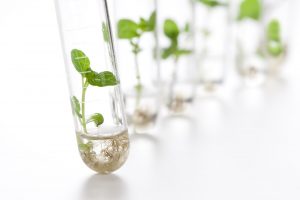Notes
Notes
VALLE DEL VINALOPÓ: FROM GREEN TO WHITE
If in mid-July we ascend to the Sierra del Cid, a mountainous formation in the province of Alicante located between the municipalities of Monforte del Cid and Petrel, and we look at the valley that is seen from there, the white floods our view and we give ourselves account of where we are ... in the Valley of the grape, in the Valley of the Vinalopó.
This color, an essential feature of our denomination of origin and a distinctive sign of our product, is the first and the last one that field workers see in our area, which in this period are many, during their working day.
When and how is the grape pocketed?

When the grape begins to mature, it is time to bag it. The crews of the field, select the clusters of grapes that have the appropriate characteristics to become a product of quality, and are putting in each one of them a paper bag of satin cellulose. Depending on the size of the cluster the bag that is put is small, medium, large or extra large. With this paper bag, open at both ends, workers cover the grapes one by one and to prevent the bag from falling off, tie each of these by its top, and with a thread of raffia, the peduncle (corner) of the cluster by which the grape stays attached to the grapevine).
This arduous task that begins around six o'clock in the morning, to avoid the hottest hours, is the one that distinguishes the table grape from this area of the rest and is what gives rise to the appellation of origin UVA EMBOLSADA DEL VINALOPÓ.

Nature and despair were the origin of this denomination.
At the beginning of the 20th century, and by an avatar of nature, which took the form of a plague, the grape that was cultivated in this area saw its continuity in danger. The desperation sharpens the wit and a farmer in the area, decided to cover each of their grapes to protect them from the plague. This generalized fact in the region and preserved until today, has led to a genuine product and protected by a designation of origin.
The bagged grape of the Vinalopó, like any product that belongs to a denomination of origin, must meet certain conditions and requirements that are regulated and that are verified by strict quality controls. The main requirement is the bagging of the grape, but other ones are added to it, ranging from its plantation in the field to its commercialization, through its packaging.
The result of these requirements and controls is exclusivity. The Vinalopó Embolsada Table Grape has a uniformity, color, texture and flavor that make it unique and internationally recognized.
Any variety of grapes grown in the area, and that meets the requirements established by the Regulatory Council of Protected Designation of Origin (CRDOP) Grape of Mesa Embolsada Vinalopó , You can enjoy this Guarantee, so in addition to the aledo variety, Victoria, ideal, Doña María and Red Globe are also included in this denomination.
FINE TUNNING
Water, sun, air and ... GREEN. This is the color that stands out in the Vinalopó Valley at this time. The color that indicates that we have to intensify the work, that the moment is approaching, that we will soon have UVA.
 After the pruning and the other works that prepare the grape vines, plants from which the grape is born, so that they can bear their fruit, the Pámpanos come, and with them the green.
After the pruning and the other works that prepare the grape vines, plants from which the grape is born, so that they can bear their fruit, the Pámpanos come, and with them the green.
The branches are the leaves of the vines. Their functions are several, from them the grape is born and they take care of it but for that, it is necessary to Despampanar. You have to remove those that are left over, those that prevent the sun, water and air from reaching the grape and leaving the necessary ones, those that will feed and protect it.
The work of flashing is not easy, the crew, people who work in the field, must go vine by vine and examine which are the branches that have to be removed and which ones have to be left, and paying close attention to what has been said, do it. It should also be added that this task, as it is said in our geographical area, is done from very early and until noon, when the heat tightens and fatigue takes its toll. Even so, the crew is happy, the work campaign begins and with it their sustenance ... They are updated to last year and the grape begins its set-up.
WHAT IS BIOTECHNOLOGY?
Biotechnology consists in the use of the biological machinery of other living beings in a way that results in a benefit for the human being, either because a valuable product is obtained or because an industrial procedure is improved.
 The biotechnological revolution reaches the crops in the 20th century. Since the 1960s, technological advances, such as the use of fertilizers enriched by chemical processes, have made it possible to increase the productivity of crops throughout the world.
The biotechnological revolution reaches the crops in the 20th century. Since the 1960s, technological advances, such as the use of fertilizers enriched by chemical processes, have made it possible to increase the productivity of crops throughout the world.
The new crop products that biotechnological generation techniques, including transgenic ones, before being marketed undergo exhaustive studies to demonstrate that they do not have risks for the health of the consumer or the environment and, therefore, are safe.
Agricultural, forestry or industrial waste acquires, thanks to biotechnology, an added value for its reuse, thus preventing its accumulation or elimination in a toxic manner. For example, from agricultural crop residues or food products can be produced enriched fertilizers (compost) or obtain protein extracts to produce animal feed products, thanks to bioprocesses involving microorganisms and enzymes.